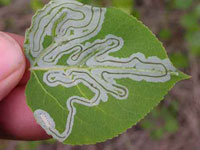Phyllocnists populiellaFootnote 1
Hosts
Most trees and shrubs
Appearance and Life Cycle

Photo credit: Pat Doak, Alaska Science Forum
Leafminers may be any one of four groups of insects- a moth, sawfly, fly or a beetle. The overwintering stage, time of year of egg laying, and the types of leaves attacked (developing or mature) varies among the many different leafmining species. Adults either deposit the eggs on the leaf surface, or insert them into the leaf. Young larvae emerge and enter the leaf between the upper and lower surface layers. There they feed on the plant tissue, passing through a series of molts until full grown. All leafmining larvae are small, flat, usually colourless and worm-shaped. Once the larvae are full grown, they pupate, either in the mined leaf, in some sheltered place outside of the leaf or in the soil. The adults emerge, mate and the females seek suitable locations to deposit their eggs, completing the life cycle.
Damage

Photo credit: Ned Rozell, Alaska Science Forum
Leafminers cause damage by tunneling or mining between the leaf surfaces, devouring the inner tissue. There are two main types of mines created by the insect: linear mines, where the larva tunnels a winding line throughout the leaf and botch mines, where the larva excavates patches, forming various shapes; circular, oblong, etc. The foliage of infested trees appears brown and undesirable. A heavy infestation causes a reduction of annual growth, but no permanent damage results. However, repeated infestations over several years will weaken the trees, making them susceptible to attack by other insects and diseases.
Control
Chemical control is rarely required due to the presence of parasites. Some species remain in the leaf during leaf drop in the fall and can be easily controlled by raking up the leaves and burning them. If leafminer infestations are severe, one of the following insecticides may be applied: carbaryl; dimethoate; diazinon; or malathion. Application of these insecticides requires critical timing to provide effective control.